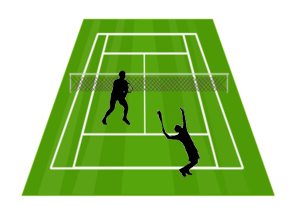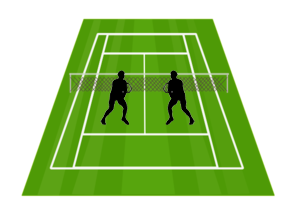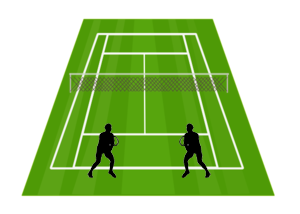Tennis Doubles Strategy
In doubles matches, you will have a partner beside you to help win some points as well. Since there are two people on the court, that means each player covers less of the court compared to singles. But don’t forget that in doubles, the outside sidelines–called the allies–are used, meaning that you’d still have to cover those extra sidelines. This can allow for a very different tennis game, since players can use different angles on their shots for plays that wouldn’t otherwise be possible in singles matches. Ergo, we’ll be going over some tennis doubles strategy as well as the main positions, which you can use to get the better of your opponents.
Tennis Doubles Strategy
In doubles matches, your biggest concern should be your positioning and ball control. Your priority will be to cover half the court, while your counterpart covers the other half. Regarding positioning, there are three main positions you and your partner can take, which might seem pretty obvious once we explain them. The first is one up and one back, meaning one player will be situated at the net while the other would be at the baseline. The second positioning is the most aggressive, the double up means that both players will be at the net. Lastly, there’s the double back (strictly defensive tennis doubles strategy), where both players stay at the baseline. Now then, let’s go over a little about each positioning.
One Up One Back
 The one up one back strategy will have one player stand at the net (the person not receiving or serving) while one player stands at the baseline (the player receiving or serving). The person at the net will be responsible for their side of the court while also covering the middle. On the other hand, the person at the baseline will have to cover their side of the court while also covering the middle for any deep shots that their partner at net cannot reach. The one up one back strategy is very versatile since it combines both offense and defense, which is why you often see this formation as games start off.
The one up one back strategy will have one player stand at the net (the person not receiving or serving) while one player stands at the baseline (the player receiving or serving). The person at the net will be responsible for their side of the court while also covering the middle. On the other hand, the person at the baseline will have to cover their side of the court while also covering the middle for any deep shots that their partner at net cannot reach. The one up one back strategy is very versatile since it combines both offense and defense, which is why you often see this formation as games start off.
The primary weakness of this tennis doubles strategy is the fact that there is a large angular gap between the partners, which a powerful crosscourt shot hit between the two could easily result in a point for the opposing team. However, there is a way to prevent this from happening. One of my favorite tennis doubles strategy to use would be the switch, where my partner and I would frequently switch sides during a point. This puts a lot of pressure on the opposing team, since it effectively diminishes the chance of hitting a crosscourt winner. Their only option left would be to hit down the line, but there are two main disadvantages to that. First, the net is higher on both sides near the posts compared to the very middle, while secondly, the ball travels less while hit down the line compared to crosscourt, which means that there is a higher chance that the ball will bounce out.
A tennis doubles strategy you can use while in this position are either the poach and the fake poach. A poach is when the player at nets runs to their partner’s side to hit the ball, with the player at baseline switching over to the other side. This is a very aggressive play that can catch your opponents off-guard, however, use it sparingly or else your opponents might catch on and use it to their advantage. When you poach, you leave your side wide open, giving your opponents the opportunity to focus their shots on where you had just been. That’s where you can use the fake poach. A fake poach is exactly what is sounds like, which is where you fake a poach by stopping halfway into your partner’s side and going back to cover your area. This can keep your opponents guessing, which is a huge part of tennis doubles strategy.
Double Up
 Double up is a very aggressive positioning, where both players go up to the net in order to apply pressure. The reason why it’s so aggressive is the fact that there is no one to cover the baseline (as in one up one back), since both players are on the offense at net. Usually, both players start off in the one up one back position (with the player at baseline either serving or receiving) and then find an opportunity to bring the baseline player to net. This often involves either a good serve or a wide shot that gives the baseline player time to rush to the net.
Double up is a very aggressive positioning, where both players go up to the net in order to apply pressure. The reason why it’s so aggressive is the fact that there is no one to cover the baseline (as in one up one back), since both players are on the offense at net. Usually, both players start off in the one up one back position (with the player at baseline either serving or receiving) and then find an opportunity to bring the baseline player to net. This often involves either a good serve or a wide shot that gives the baseline player time to rush to the net.
This tennis doubles strategy is the same one used in singles, although it is formally known as serve-and-volley in 1vs1 matches. The only difference, however, is that there is already someone at net, which makes it much easier to find an opportunity to bring the baseline player to net.
The double up strategy is ideal for putting a lot of pressure on the opponent, since whatever the opponents hits will be returned right back by either one of the net players. This results in less time for the opposing team to respond to shots, and can open the double up players to new angles that can have the opponent constantly moving. Also, overheads and drive volleys. These are very powerful shots you can use that are difficult for the opposing team to return. This tennis doubles strategy is highly recommended for tall people with a wider reach or for players who have a powerful serve and great net skills.
Double Back
 The double back strategy is strictly for defensive purposes, and should only be used if you and your partner prefer to play it safe. Most of the time, it is used when the opposing team are either double up or in an aggressive one up one back positioning.
The double back strategy is strictly for defensive purposes, and should only be used if you and your partner prefer to play it safe. Most of the time, it is used when the opposing team are either double up or in an aggressive one up one back positioning.
The main strategy with this positioning is to return the opponent’s powerful shots until an opportunity arises to punish them (typically with a lob or an offensive shot). Staying at the baseline allows for powerful shots as well as eliminating the chance of passing shots.
The main disadvantages of this tennis doubles strategy are angular shots in the forecourt, drop shots, and the fact that your team provides no net pressure. That’s why it’s also important to change your tennis doubles strategy up during a match in order to respond to live situations that could result in your team winning the point.
